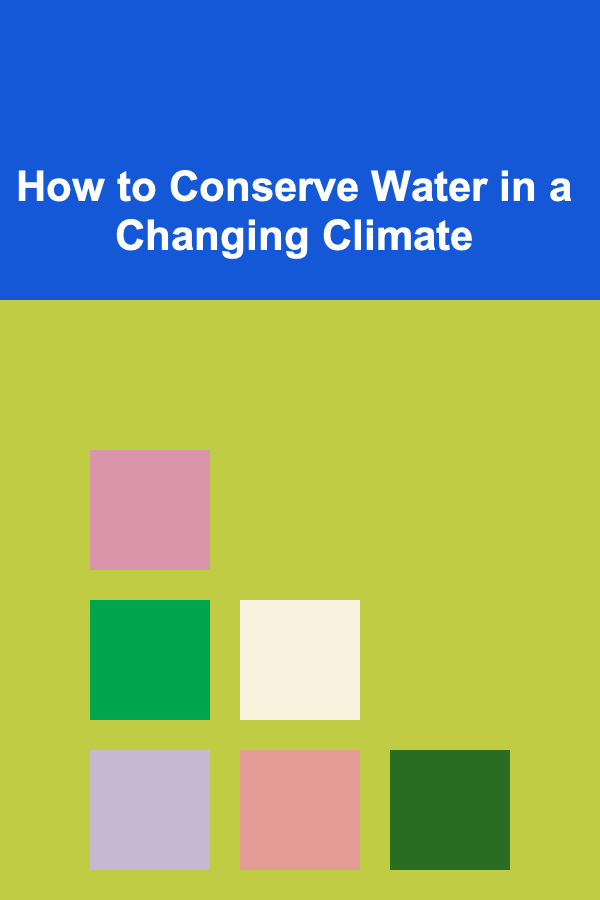
How to Conserve Water in a Changing Climate
ebook include PDF & Audio bundle (Micro Guide)
$12.99$11.99
Limited Time Offer! Order within the next:

Water conservation is one of the most critical issues we face in today's rapidly changing climate. With global temperatures on the rise, extreme weather patterns becoming more frequent, and droughts affecting various regions, the need to conserve water has never been more urgent. Not only does water serve as the foundation for all life on Earth, but it is also essential for agriculture, energy production, and industrial processes. As climate change accelerates, understanding how to conserve water effectively becomes crucial for both environmental and economic sustainability.
In this article, we will explore the importance of water conservation, the challenges presented by a changing climate, and practical strategies that individuals, communities, and governments can implement to ensure a sustainable water future.
The Importance of Water Conservation
Water is a finite resource, and its availability is not evenly distributed around the globe. While some areas have abundant fresh water, others face water scarcity. According to the United Nations, nearly 2 billion people worldwide live in countries experiencing high water stress, and climate change is expected to exacerbate this problem. Rising temperatures, altered precipitation patterns, and increasing evaporation rates are already having severe impacts on water supplies.
Conserving water is crucial for several reasons:
- Maintaining Ecosystems: Water supports ecosystems, wildlife, and biodiversity. Over-extraction of water can lead to the destruction of habitats and loss of species.
- Ensuring Agricultural Production: Agriculture accounts for approximately 70% of global water use. Without sufficient water, crop yields decrease, leading to food insecurity and economic instability.
- Supporting Energy Production: Water is used in power generation, including hydropower and thermoelectric plants. Insufficient water supply can lead to energy shortages.
- Promoting Human Health: Access to clean water is vital for sanitation, hygiene, and disease prevention. Water scarcity increases the risk of waterborne diseases.
Given these factors, conserving water is not only an environmental issue but also a social and economic imperative.
The Impact of Climate Change on Water Availability
Climate change affects water availability in various ways. As the planet warms, regions that rely on specific weather patterns may experience altered rainfall, prolonged droughts, or intensified flooding. The key climate-related factors influencing water availability include:
1. Changes in Precipitation Patterns
Climate change leads to shifts in rainfall patterns, causing some areas to experience more frequent and intense storms, while others face extended dry spells. These changes disrupt water cycles, leading to unpredictable water availability.
For example, the Western United States has experienced severe droughts in recent decades due to changing precipitation patterns. In contrast, parts of South Asia have seen more intense monsoons, leading to floods and water quality concerns. Such fluctuations in rainfall make it difficult to manage water resources effectively, as water infrastructure must be designed to handle both droughts and floods.
2. Rising Temperatures and Evaporation
Higher global temperatures lead to increased evaporation rates from lakes, rivers, and reservoirs. This reduces the amount of surface water available for consumption, especially in regions where water is already scarce. Additionally, higher temperatures increase the demand for water in agriculture, industry, and households, exacerbating water stress.
3. Melting Glaciers and Snowpacks
Many regions depend on glacial meltwater to supply freshwater throughout the year, particularly during dry seasons. However, rising temperatures are causing glaciers and snowpacks to melt at an accelerated rate. While this may initially increase water flow in some areas, it is not a sustainable source of water. As glaciers shrink, these regions will face water shortages in the long term.
4. Saltwater Intrusion
As sea levels rise, saltwater can infiltrate freshwater aquifers along coastal areas, making the water undrinkable. This phenomenon, known as saltwater intrusion, threatens the water supply in many low-lying regions and can make it challenging to maintain fresh water for drinking and irrigation.
These impacts demonstrate the urgent need for adaptive water management strategies to cope with a changing climate.
Practical Strategies for Water Conservation
Water conservation efforts can take many forms, from individual actions to large-scale policy interventions. Below, we outline some practical strategies for conserving water in a changing climate.
1. Efficient Water Use in Agriculture
Agriculture is the largest consumer of water globally. Improving water efficiency in farming is therefore one of the most effective ways to conserve water.
a. Drip Irrigation
Drip irrigation delivers water directly to the roots of plants, minimizing water loss due to evaporation or runoff. This system can reduce water consumption by up to 50% compared to traditional irrigation methods. By using drip irrigation, farmers can maximize crop yield while minimizing their water usage.
b. Soil Moisture Management
Farmers can use soil moisture sensors and other tools to monitor water levels in the soil. By determining the exact amount of water needed, they can avoid over-irrigation and reduce water waste. Additionally, mulching and cover crops can help retain soil moisture, reducing the need for frequent irrigation.
c. Rainwater Harvesting
Rainwater harvesting systems collect and store rainwater for agricultural use. This provides an alternative to groundwater or surface water, especially during dry periods. Farmers can use stored rainwater for irrigation, reducing their reliance on other water sources.
d. Drought-Resistant Crops
Planting drought-resistant crops can help farmers cope with changing rainfall patterns and reduce water demand. These crops are designed to thrive with less water, making them more resilient to drought conditions.
2. Urban Water Conservation
Cities face unique challenges in water conservation due to the high demand for water in households, industries, and public services. Implementing efficient water management strategies in urban areas can help reduce consumption.
a. Water-Efficient Appliances
The installation of water-efficient appliances, such as low-flow showerheads, toilets, and washing machines, can significantly reduce household water use. These devices use less water while maintaining performance, helping to conserve resources without compromising quality of life.
b. Water Recycling and Reuse
Water recycling involves treating wastewater and reusing it for non-potable purposes, such as irrigation, industrial processes, or toilet flushing. This reduces the demand for freshwater and lowers the energy required for water treatment.
c. Rainwater Harvesting for Urban Areas
In urban areas, rainwater harvesting can provide an alternative water source for landscaping, car washing, and other non-potable uses. Installing rainwater collection systems on rooftops or other surfaces can help reduce the burden on municipal water systems, especially during dry periods.
d. Leak Detection and Repair
Water loss through leaks in pipes and infrastructure is a significant issue in many cities. Regular maintenance and repair of water systems can prevent leaks, ensuring that water is not wasted. Modern technologies, such as smart meters and sensors, can help detect leaks early and reduce water loss.
3. Protecting and Restoring Natural Water Sources
Protecting natural water sources, such as rivers, lakes, and wetlands, is essential for maintaining water availability in the long term.
a. Conservation of Wetlands
Wetlands play a vital role in water filtration and storage. They act as natural sponges, absorbing excess water during heavy rainfall and releasing it slowly during dry periods. Protecting and restoring wetlands can improve water quality and help regulate water flow, reducing the risk of both floods and droughts.
b. Reforestation and Watershed Management
Forests play a crucial role in maintaining the health of watersheds by reducing soil erosion, improving water infiltration, and regulating water flow. Reforestation efforts and sustainable land management practices can help restore watersheds and protect the quality of freshwater sources.
c. Preventing Pollution
Water pollution from industrial runoff, agricultural chemicals, and untreated sewage can contaminate freshwater supplies and reduce their availability. Implementing stronger regulations to prevent pollution and promoting sustainable practices can help protect water quality.
4. Education and Advocacy
Raising awareness about the importance of water conservation and the impacts of climate change on water resources is essential for fostering a culture of responsible water use.
a. Community Education Programs
Local governments, NGOs, and schools can play a critical role in educating communities about water conservation practices. Outreach programs can teach people how to reduce water waste, improve water efficiency, and protect local water resources.
b. Advocacy for Water Policy Reform
Advocacy groups can push for stronger water policies that promote conservation, equitable distribution, and sustainable management. By working with policymakers, these organizations can help create laws and regulations that protect water resources for future generations.
Conclusion
Water is one of the most precious resources on the planet, and its conservation is crucial in the face of a changing climate. As temperatures rise, weather patterns shift, and water availability becomes increasingly uncertain, it is essential that we take immediate action to conserve and manage water more efficiently. By implementing water-saving technologies, improving agricultural practices, protecting natural ecosystems, and raising public awareness, we can ensure that water remains available for future generations. The time to act is now---our ability to conserve water today will determine the health and prosperity of our planet tomorrow.

Corporate Trainer's Handbook: Best Practices for Boosting Skills and Enhancing Organizational Performance
Read More
How to Create a Cozy Reading Nook in Your Personal Library
Read More
How to Diversify Your Dropshipping Supplier Portfolio to Minimize Risk
Read More
How to Mix and Match Different Types of Light Fixtures
Read More
How to Utilize Under-Bed Storage Effectively
Read More
How to Create a Monochromatic Makeup Look
Read MoreOther Products

Corporate Trainer's Handbook: Best Practices for Boosting Skills and Enhancing Organizational Performance
Read More
How to Create a Cozy Reading Nook in Your Personal Library
Read More
How to Diversify Your Dropshipping Supplier Portfolio to Minimize Risk
Read More
How to Mix and Match Different Types of Light Fixtures
Read More
How to Utilize Under-Bed Storage Effectively
Read More